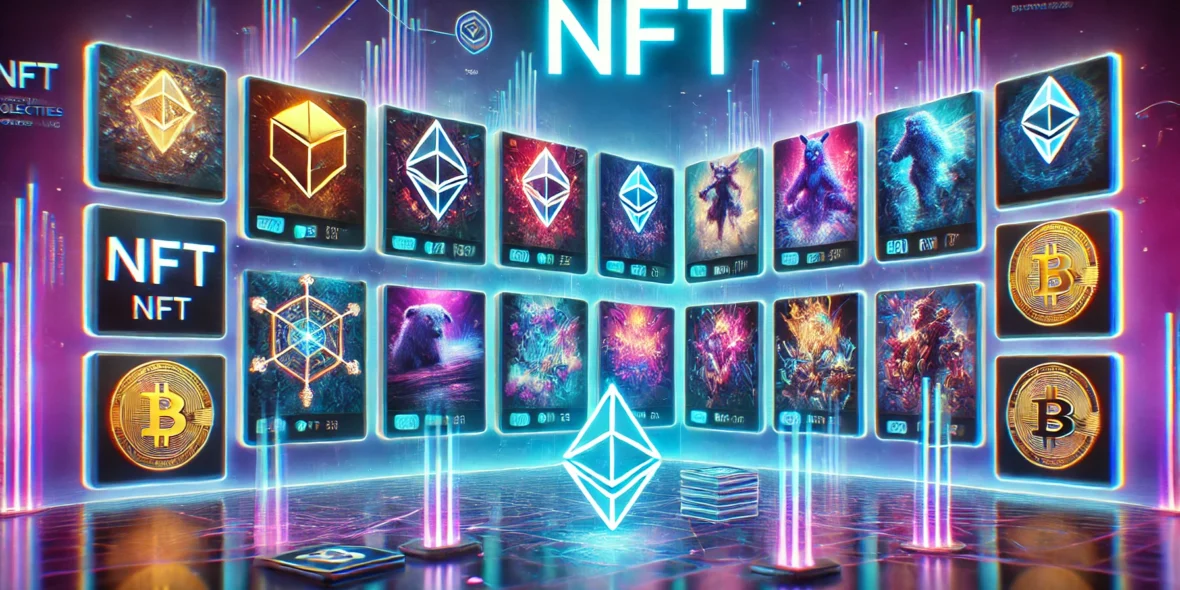NFTs are digital tokens representing ownership of a virtual asset—a work of art, music, video, or digital real estate. The great thing about them is that each is one-of-a-kind asset. They’re stored on a blockchain and associated with a unique digital certificate of authenticity and ownership.
Let’s use an NFT as an analogy for a collectible card. Anyone can take a screenshot of the card, but the NFT holds the official ownership proof. Whoever holds the private keys to the token owns the rights to it. It’s similar to the difference between buying an original painting or a print—you can still look at the print, but it isn’t the original.
You cannot trade NFTs one for one, unlike with cryptocurrency. When you trade one Bitcoin for another Bitcoin, you still have the same asset. But when you trade an NFT for a different NFT, you’re getting something totally different. While two different NFTs may appear the same, their metadata, ownership history, and value make them entirely different.
How the Origins of NFTs Contributed to the Rise of Web3 Technology
Kevin McCoy minted the very first NFT in 2014. It was a pixelated octagon with shifting colors that made it look like an animated octopus. Fast forward a few years, and the same NFT sold for $1.47 million at Sotheby’s—insane when you think about it.
But the journey to mainstream NFT adoption wasn’t entirely smooth. The early NFTs existed in blockchains like “Namecoin,” which made transactions and storage complicated. McCoy actually lost his OG Quantum NFT because Namecoin required constant renewal fees, which he didn’t keep up. That mistake caused ownership disputes, which showed the technology for NFTs was still in its experimental phase.
The real revolution came when NFTs transitioned to the Ethereum network. The smart contract functionality of the ETH network allowed the coding of data into the asset, simplifying buying and selling transactions, along with seamless ownership verification.
NFTs exploded in popularity during the 2021 pandemic, with the first big sale of an NFT since McCoy’s Quantum coming from the artist, Beeple. He minted his physical painting “Everydays: The First 5,000 Days” as an NFT, and it went on auction at Christie’s. The digital artwork sold for a gob-smacking $69 million.
All of a sudden, NFTs were the real deal, and the mania took off with crypto enthusiasts. We saw a rush to form new projects, with “Bored Apes,” “Crypto Kitties,” and “Crypto Punks” selling for millions of dollars a piece.
NFTs—More Than Just Digital Collectibles
Most people associate NFTs with pixelated avatars and hyper-priced jpegs. However, the technology behind the NFT can be applied for a great many things other than collectibles.
NFTs can be used as digital proof of ownership for just about anything—real estate, artwork, music, concert tickets, memberships, etc. Since it’s cryptographically stored in a blockchain, NFTs cannot be counterfeited or altered, which is perfect for authenticity-based markets.
In real estate, NFTs might facilitate the buying and selling of property by bypassing agents and contract negotiations. Instead of waiting for weeks for approvals, ownership could be transferred by a smart contract in an instant when buyer/seller conditions are fulfilled. The same principle can be extended to inheritances, intellectual property, and sales contracts.
Even digital identities may be tied to NFTs. Rather than relying on centralized databases, people may store personal information in an NFT, controlling which information they share with others. This could revolutionize the lives of people with no traditional forms of identification.
Another interesting use of NFTs? Fractional ownership. Currently, desirable assets like real estate and artwork are for the rich and famous. But imagine multiple people being able to share ownership of a painting by Picasso or a plot of prime real estate. That’s all facilitated by NFT tech and it’s already a thing—just look at companies like Master Works.
The Process of Creating NFTs
Creating an NFT, referred to as “minting,” is the process of transforming digital files into digital assets stored on the blockchain. The process generally involves the integration of smart contracts that transfer ownership and track transfers.
Once minted, each NFT is given a distinctive identifier associated with a particular blockchain address, publicly confirming ownership. Although several different NFTs of the same object may be minted, each token will be different due to its distinctive identifier.
NFTs—Behind the Scenes
Minting is the act of creating an NFT. This is the process where a digital asset is tokenized, placed on a blockchain, and assigned a permanent identity which is trackable through a decentralized ledger, providing total transparency to the ownership of the digital asset. The metadata of the NFT—its author, transaction history, ownership—gets stored in a permanent format, so it can be easily verified.
Every NFT comes with a special identifier linked to a wallet address. It’s just like a serial number you find laser-embedded into a diamond. The same image can be copied and pasted a thousand times, but only the owner of the original NFT holds the real ownership record.
Other blockchains handle NFTs differently. The most well-known NFT network is Ethereum, but you can mint NFTs on Solana, Polygon, and even the Bitcoin network. That’s right—yes, Bitcoin NFTs actually exist, though they’re referred to as “Ordinals.”
Ethereum, for example, is a popular choice for minting, but it’s fallen out of favor due to the high gas fees involved, and projects now prefer next-gen networks like Solana for its low-cost transactions.
Understanding Fungibility in Blockchain Technology and NFTs
Fungibility is a fundamental concept in the cryptocurrency market. It’s the characteristic by which any cryptocurrency unit is identical to any other identical type of unit. That is, any Bitcoin is equivalent in worth to any other Bitcoin in an exchange, just as any Dollar note is equivalent in worth to another—in other words, my $100 bill has the same purchasing power as your five $20 bills. This substitutability facilitates the use of cryptocurrency as a secure medium of exchange in the digital economy.
Diverse Applications of NFTs
NFTs were first popularized in the digital artwork and collectibles market, but later their application extended to other markets.
Photographers tokenize their work by selling full or partial ownership to buyers. Ocean Intersection collections consist of lovely ocean and surfing photographs made accessible in the form of NFTs.
NFTs have been created for celebrities and sporting figures, allowing fans to buy unique digital memorabilia. Digital trading cards, both collectible and those used in video games, are some of the most popular NFT assets.
There’s also the adoption of NFTs in the gaming space, using them to trade skins and other digital assets on secondary marketplaces.
Certain NFTs offer membership to exclusive clubs or unlock VIP privileges on virtual or physical platforms. Anything in the virtual world, including digital property or avatar wearables, can be represented by NFTs. Digital artwork, from pixel art like Crypto Punks to abstract images can be minted in NFTs.
Domain names for websites are minted NFTs, providing a decentralized ownership strategy. Artists can tokenize their music, enabling buyers to buy specific rights or exclusive material.
There are many possible use cases for NFTs outside of mere financial speculation. While we’re not going to see the same kind of money flood into the space in the rest of the decade that we did in the early 2020s, that doesn’t mean the tech is defunct and dead.
NFTs And Web3—The Next Evolution of Digital Art
Think of an NFT as a digital keycard which unlocks content, promotions, or special events. Brands are using smart contracts attached to NFTs to bring more value to customer experiences. NFTs can evolve over time, unlocking new features based on how the customer engages with it.
For artists, it means total control of their work with no need for middlemen in the form of galleries or agencies. Selling artwork as an NFT means immediate global visibility and direct income, with smart contracts guaranteeing creators royalties for each time their work is resold.
Artists in the traditional art market only get paid when they sell their artwork for the very first time—NFTs change this model forever. This model makes digital artwork more valuable, as people can demonstrate ownership in a manner that wasn’t previously available in the conventional art market.
Along with artwork and collectibles, NFTs are opening up new business models in digital spaces. By linking digital assets to a blockchain, NFTs are revolutionizing proof-of-ownership-based industries. Tickets for events, memberships, and deeds to virtual real estate are already being tokenized, allowing for instant verification and the elimination of fraudulent transactions.
Platforms like The Sandbox and Decentraland sold digital land lots in the shape of NFTs, which can be sold, bought, or leased by users. With the expansion of the metaverse, such properties may be of real-world value, and some owners are already benefitting from it. A good example is rapper, Snoop Dogg, who’s $300,000 investment into the “Sandbox” metaverse is now worth a staggering $4.8 million
NFTs – The Good, The Bad, and the Overhyped
NFTs were stirring up excitement in the online market in the early 2020s, but today—they’re virtually defunct. While there are still ongoing projects and marketplaces offering NFTs, the craze of the 2021s and 2022s has faded into obscurity. Most NFTs, apart from a select few, have seen massive declines in price from the peak of the market in 2022.
A great example is the influencer Logan Paul, who famously paid $623,000 for an NFT, only to have its value crash to a measly $10. That’s an epic crash out. Along with this price crash problem, it turns out NFTs aren’t as secure as people thought. They also aren’t what people thought they are at all.
For instance, if you bought a CryptoPunk, you didn’t actually buy the image of the pixilated artwork—you bought a link to the image on the blockchain—not the asset itself. Then there’s the issue of the digital asset itself, whether it’s an image, video, or music, being available for anyone to view online. Anyone can save, share, or replicate it. Right-click, save-as¬—that’s all it takes to get a copy of the asset.
Legally speaking, it is still copyright infringement to pirate an NFT, though good luck in tracking down anyone reproducing your digital artwork. The blockchain records ownership, but it doesn’t police the internet. When someone captures a screenshot of a tokenized image and offers it as their artwork, it’s up to the original artist to enforce their rights, which can be a nightmare.
And then there’s the liquidity—or the lack thereof. While Bitcoin and Ethereum can be quickly sold for cash or other tokens, NFTs depend on the right buyer at the right time. When the market for a certain kind of NFT falls off, liquidity dries up and it’s hard to sell it.
Unlike crypto, which has millions of traders, and deep liquidity pools, the markets for NFTs are highly specialized. You might have something of great value, but if no one will buy it—is it really worth anything?
So, Are NFTs Worth the Hype?
NFTs have long since progressed beyond pixelated monkeys and overpriced jpegs. They’ve introduced real innovation in digital ownership, though with risks that cannot be ignored.
NFTs offer new opportunities for artists to make money and protect digital work, although piracy risks and the issue of duplication remain real concerns. Investors looking for a quick turnaround in the money should be mindful of market volatility and the lack of liquidity that we discussed earlier.
Web3 is still in its infancy, and while the future of digital ownership is being written by NFTs, it doesn’t necessarily guarantee long-term success. There will be projects that will be successful, but most will be forgotten.
If you’re looking to get in on the NFT action, do your research. All NFTs are not created equal, and the market shifts rapidly. That said, NFTs changed the nature of digital assets—and the tech isn’t going away anytime soon.







